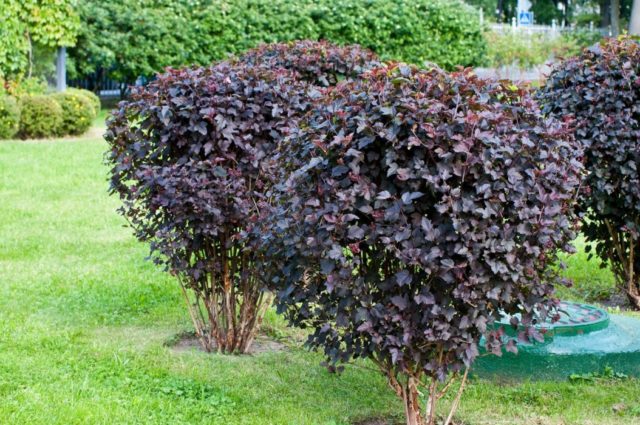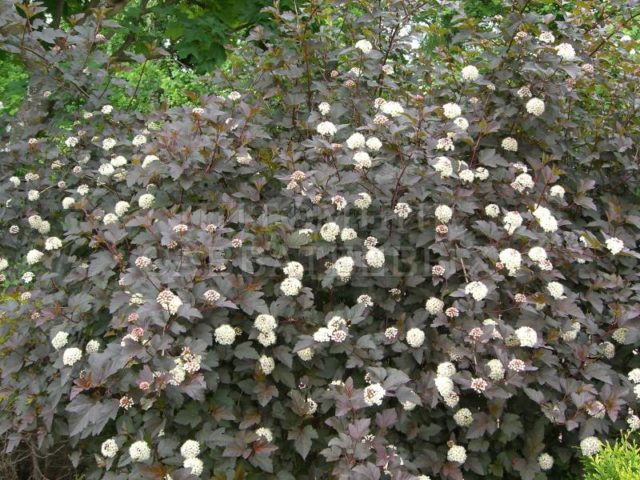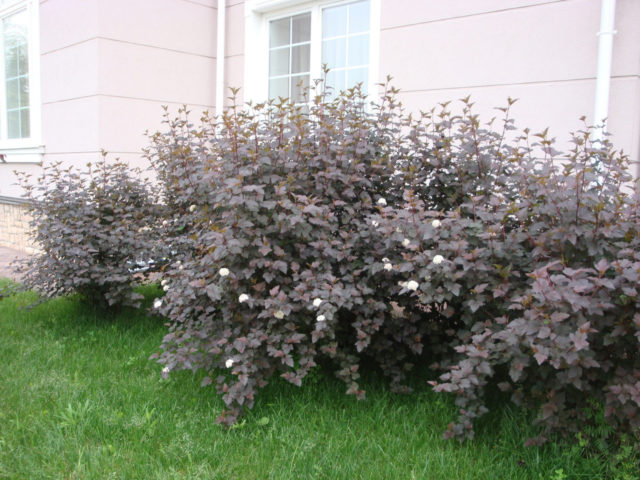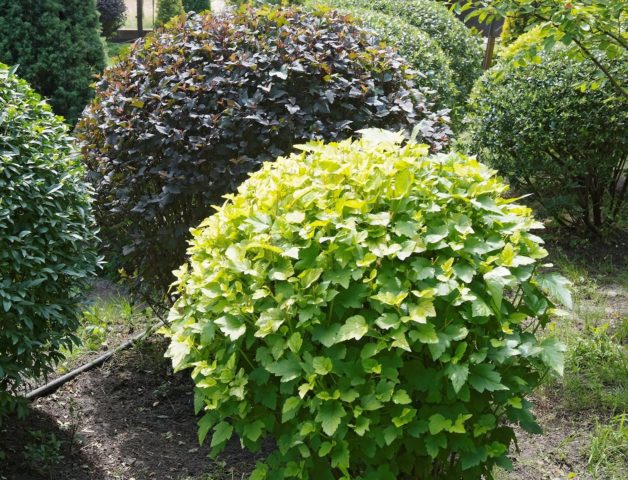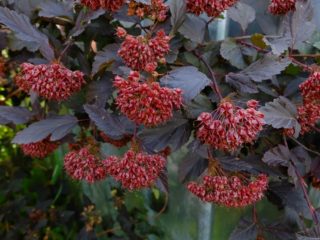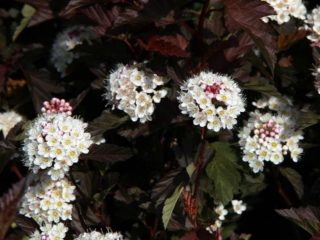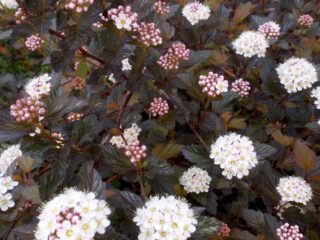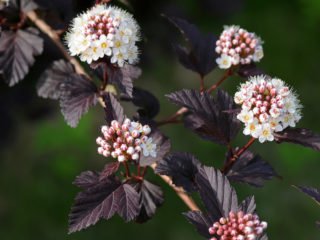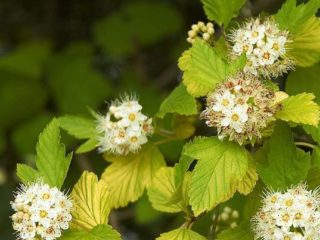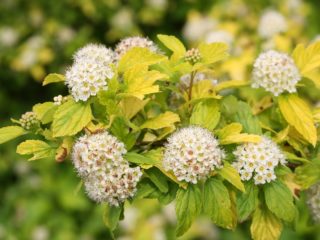Content
Diablo D'Or is an ornamental garden plant that can grow in any, even the most unfavorable conditions. The plant has an attractive appearance throughout the warm season. The vital energy of the viburnum leaf carp is such that even in conditions of severe pollution and gas contamination of urban ecosystems, it grows into full-fledged adult plants without any problems. Thanks to these properties, the plant is widely used in urban landscape design.
Description of the vesicular carp Diablo D'Or
Diablo d'Or is a deciduous shrub from the Rosaceae family. The bush consists of 2-3 dozen drooping branches growing from the center and forming a hemispherical crown. The height of the bush reaches 3 m. The lifespan of the plant is 20-30 years, but there are also old-timers whose age exceeds 50 years.
The bark of the stems is dark burgundy. The leaves, arranged in pairs, have a three- or five-lobed shape. Their length reaches 4-5 cm.The color of plants in sunny areas is red-violet, while that of bushes growing in the shade is purple-green. In autumn the color of the leaves changes to golden.
During flowering, the vesicular carp is covered with many pale pink flowers, collected in corymbose inflorescences. The diameter of flowers is 1.5-2 cm, inflorescences are up to 5 cm. Depending on climatic conditions, flowering begins at the end of June and beginning of July. Flowering duration is 15-20 days.
Flowering and fruiting begin in the 4th year of the vesicular carp's life. The fruits of the bladderwort are multi-leafed, collected in several pieces.
Diablo D'Or in landscape design
Bladderwort is widely used in landscape design. Most often, bladderwort is used to create hedges and hide problem areas. Having a relatively high growth rate (up to 40 cm per year), it is excellent for design tasks.
When planted in sunny areas (where the foliage turns dark), it makes an excellent background for light-colored perennials. Plantings in the shade (with greenish foliage) are well suited for filling any mixborders, as well as for single compositions.
The crown of the bladderwort tolerates pruning well, so the vegetative part of the bladdercarp can be formed in any form convenient for the designer.
Planting and caring for Diablo D'Or
The bladderwort feels good in any area. Lighting, soil fertility, neighbors and other factors play practically no role for him. Certain restrictions on the planting site are imposed only by the acidity of the soil and the terrain.Diablo d'Or should not be grown in alkaline soils (pH greater than 7), or in lowlands or areas with excessively wet soil.
Caring for the bladderwort consists of regular watering, fertilizing and loosening the soil. Since bladderwort has a significant growth rate and is quite bushy, it may require pruning.
Diablo D'Or is quite frost-resistant (4th frost resistance zone, can withstand temperatures down to - 35 ° C). Young plants, which are no more than 2 years old, can freeze slightly, so they require shelter for the winter.
Preparing the landing site
The planting site for the Diablo D'Or vesicle does not require any specific preparation. When planting young plants with a bare root system, it is recommended to apply organic fertilizers (in the fall, under the snow during spring planting or in mid-summer during autumn planting), but such preparation is not mandatory.
Landing rules
Bladderworts from containers can be planted throughout the warm season. Planting of bladderworts with a bare root system is carried out in early spring before the leaves bloom or in mid-September.
A few hours before planting, you need to soak the roots in warm water. A hole 50-60 cm deep is dug under the bush, into which a mound of nutritious soil (a mixture of earth and humus) is poured. Next, a bush is placed on this hill, the roots of which are straightened. After this, you need to sprinkle them with soil, leaving the root collar slightly above the ground level.The soil is compacted and the plant is watered abundantly.
It is advisable to carry out the first watering using Kornevin’s solution in warm water (2-3 °C higher than the air temperature). After the water is completely absorbed, the soil within a radius of 50 cm from the central part of the bush is mulched with solid material. The material used is straw, sawdust, or a simple mixture of peat and dry garden soil.
Watering and fertilizing
In general, the intensity of watering the bladderwort depends on the climate, soil type and age. In hot climates and loamy soil, bladderwort needs regular watering throughout the summer.
The frequency of watering is 3-4 days, the volume of water poured per watering is quite large - up to 40 liters. Heavier soils (for example, clay) require less intense watering, no more than once a week, and no more than 20 liters of water.
Feeding is carried out twice per season:
- In early spring, organic fertilizers are preferred (mullein solution, bird droppings, rotted manure, etc.). It is also recommended to use a mixture of organic and mineral fertilizers: dilute 500 ml of mullein in 10 liters of water, 1 tbsp. l. ammonium nitrate and 1 tbsp. l. urea.
- In mid-autumn, mineral fertilizers are applied. To do this, dissolve 1 tbsp in 10 liters of water. l. nitroammofoski.
The given feeding rates are used for young plants whose age does not exceed 10 years. If the plant is already mature (over 10-15 years old) or its size is already quite large (the diameter of the bush hemisphere is more than 3 m), the norms are increased by 1.5 times. In this case, the concentration of fertilizers remains the same, but a larger amount of solution is used.
Trimming
There are two types of pruning of bladderwort, like most ornamental plants:
- sanitary;
- formative.
Sanitation is traditionally done after winter and aims to free the bush from diseased, dried and frostbitten shoots. This standard procedure consists of completely removing shoots from the plant that are not capable of vegetating and flowering.
Formative pruning, which gives the bushes the look required from the designer’s point of view, can be done at any time of the year. Its main stages are carried out either in the spring before the buds begin to open, or in the fall, after the end of the growing season.
There are two methods of formative pruning:
- Getting a wide bush. The shoots are pruned at a height of 40-50 cm. At the same time, all trunks, both old and young, are preserved. A year later, pruning is performed at a height of 60 to 80 cm, a year later - even higher, etc.
- Obtaining a fountain-shaped bush. All thin and young shoots are cut out at the base, leaving 5-6 of the strongest and most powerful. The remaining shoots are cut at a height of about 1.5 m from the base.
During the season, corrective pruning is performed to give the bush its final shape. During flowering, pruning is not performed.
Preparing for winter
Plants older than 2 years do not need any specific preparation for winter. It is advisable to cover young plants for the winter by sprinkling the base of the bush with a layer of sawdust up to 30 cm high, and wrap the shoots in polyethylene.
Reproduction
Seed propagation of Diablo D'Or is practically not used, since plants with this method do not inherit the color characteristic of the variety.
Propagation by cuttings is mainly used. For this, shoots of the current year are used.At the end of summer they are divided into cuttings with 4 to 6 buds. After harvesting, the cuttings are soaked in Kornevin’s solution. Next, they are planted in a mixture of sand and peat, taken in equal proportions.
After planting, the cuttings are watered and covered with film or plastic bottles. Caring for cuttings involves regular watering and ventilation. At the end of autumn, the cuttings are covered with a layer of sawdust. During the winter, their root system is formed, and with the arrival of spring, the rooted cuttings are planted in open ground.
Diseases and pests
The plant has very high resistance to diseases and pests. We can say that Diablo D’Or is not afraid of either one or the other. The only thing you should pay attention to is the plant’s vulnerability to fungal diseases if watered too intensively.
If a plant is infected by a fungus due to excessive moisture, it is necessary to significantly limit watering, and either remove the damaged shoots or treat them with copper-containing preparations. In any case, with normalization of watering regimes, the plant will very quickly cope with the infection, and the next year it will fully recover.
Conclusion
Diablo D'Or is an unpretentious plant that is widely used in landscape design. The plant has a long-lasting decorative effect, lasting almost the entire warm season. It can be used in group plantings as a hedge, as part of a mixborder or as a free-standing plant. The bladderwort can grow in any conditions; it thrives both in rural areas and in urban areas.
